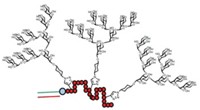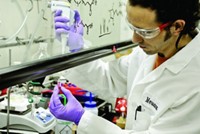Advertisement
Grab your lab coat. Let's get started
Welcome!
Welcome!
Create an account below to get 6 C&EN articles per month, receive newsletters and more - all free.
It seems this is your first time logging in online. Please enter the following information to continue.
As an ACS member you automatically get access to this site. All we need is few more details to create your reading experience.
Not you? Sign in with a different account.
Not you? Sign in with a different account.
ERROR 1
ERROR 1
ERROR 2
ERROR 2
ERROR 2
ERROR 2
ERROR 2
Password and Confirm password must match.
If you have an ACS member number, please enter it here so we can link this account to your membership. (optional)
ERROR 2
ACS values your privacy. By submitting your information, you are gaining access to C&EN and subscribing to our weekly newsletter. We use the information you provide to make your reading experience better, and we will never sell your data to third party members.
Biological Chemistry
Practical Platform
Adimab believes its yeast-based antibody discovery system could change how biotherapeutics are found
by Lisa M. Jarvis
July 27, 2009
| A version of this story appeared in
Volume 87, Issue 30

Wearing stylish glasses and a jacket without a tie, Dartmouth College engineering professor Tillman U. Gerngross looks the part of an Ivy League academic. But after talking to him for a few minutes about Adimab, the company he recently formed with Massachusetts Institute of Technology chemical engineering professor K. Dane Wittrup, it becomes clear that he would be just as at home in a boardroom as in a lecture hall. The two professors have developed a yeast-based antibody discovery and optimization platform that, if it works as easily as Gerngross suggests, could represent an important new technology for the biopharmaceutical industry.
In a nutshell, Adimab has managed to create a fully synthetic human immune system in yeast. With roughly 10 billion yeast cells, each populated by a unique human antibody, the company’s discovery platform boasts a diversity that rivals existing fragment-based antibody discovery systems but with the advantages of whole antibodies.
Add a fluorescently tagged antigen to Adimab’s yeast-antibody library, and yeast cells that make an antibody that binds to the antigen light up. Then the library is run through a cell sorter that weeds out the nonbinding cells and identifies which antibodies express well and bind to the antigen most tightly. Next, the whole process is reversed by subjecting the hits to a growth medium that causes the yeast to secrete the antibodies, which are then collected and purified. The result is a collection of potential drug candidates, each one a human immunoglobulin G (IgG) antibody like the ones created by human B cells.
“We have come up with a way where you walk in the door with an antigen and, a few weeks later, you walk away with fully human antibodies against your target,” Gerngross says. “Antigen in, hundreds of antibodies out, in a few weeks—there is no technology that can do that.”
Gerngross’ name might sound familiar: He was one of the masterminds behind GlycoFi, the biotech firm that managed to coax yeast into adding complex sugars to a protein. Merck & Co. snapped up the company in 2006 for a cool $400 million, and GlycoFi’s yeast manufacturing platform subsequently became the basis for Merck’s push into the biosimilars arena (C&EN, Jan. 12, page 28).
The question now is whether lightning can strike twice for the Dartmouth professor. If Adimab’s technology works, it could significantly abbreviate the time-consuming process of developing a therapeutic antibody. More important, it could take much of the guesswork out of antibody discovery by enabling researchers to pick the best antibody for a target early on in development. Adimab has attracted funding from several prominent life sciences venture-capital firms. More recently, two big drug companies became sufficiently convinced of the technology’s value to test-drive it.
Investors often worry that companies spun out of academia are based on too tenuous a link between an interesting idea and commercial reality, but Adimab was started to fill a gap in the market.
After Merck bought GlycoFi, Gerngross gained an insider’s perspective on the importance of unencumbered access to antibody discovery technology. Big pharma companies were striving to create biopharmaceutical businesses but found that they “really had no good options” among antibody technology providers, Gerngross says.
If a drug company wanted to develop an antibody, its choices at the time were to use in vivo technology, offered by companies such as Medarex and Abgenix, or phage-display technology, used by firms such as Cambridge Antibody Technology. The in vivo method involves injecting an antigen into a genetically engineered mouse, which then produces an antibody. With phage-display technology, genetic engineering is used to create a library of antibody fragments displayed on the surface of Escherichia coli; researchers then introduce an antigen to the library and extract the members it latches onto. These fragments have to be engineered into full antibodies before they become drug candidates.
In both cases, it can take six months to more than a year before an antibody is delivered to a customer. But Gerngross sees more significant scientific and commercial limitations. The biggest issue, he says, is that the technology companies are limited in what they can offer new customers. They made broad deals with drug companies to develop antibodies, shutting other firms out from large areas of research. “The gatekeeping process prevented you from working on a particular target,” Gerngross says.
Furthermore, the few companies with viable antibody discovery technology have been swallowed up by their partners. In 2006, Amgen paid $2.2 billion for Abgenix, and AstraZeneca laid out $1.6 billion for the 80% of Cambridge Antibody Technology it did not already own.
There are also scientific issues associated with older antibody discovery technologies. Although Abgenix refined in vivo technology to enable a mouse to produce a fully human antibody, the diversity of the antibodies a mouse can make is limited, notes Carolyn Bertozzi, a chemistry professor at University of California, Berkeley, who studies cell-surface interactions.
Meanwhile, the success of phage-display technology rests on the notion that the antibody fragments (Fabs) displayed on E. coli will function in the same way as the entire antibody. But, Bertozzi points out, “there’s actually a pretty huge canyon between identifying that little Fab region and actually having a functional antibody that’s fully humanized and therefore tolerated by the human body.”
Gerngross and his partners spent about a year figuring out how to navigate the crowded intellectual property around antibodies and another year honing their discovery platform and business strategy. They are convinced that Adimab’s approach offers significant scientific and commercial advantages over older technologies.
For example, under traditional methods, a company’s researchers might know they have found an antibody fragment that binds to an antigen, but they won’t know what response is elicited from that action once that fragment is formatted back into a full antibody. According to Gerngross, it has become clear that hitting the right spot, or epitope, on a given antigen matters. “You can hit a receptor and shut it down, or you could hyperactivate it. The therapeutic outcome of an antibody binding an antigen can be drastically different,” he says.
When Adimab tested out its technology on commercially relevant antigens, it discovered hundreds of fully human antibodies with binding affinity for each one. In theory, having an entire suite of antibodies lets a company choose the best drug at the outset and box out the competition. “We feel we can so exhaustively scan an antigen that, if there’s a new target, you can find all the possibilities,” Gerngross says. “By virtue of protecting all those solutions, you almost virtually protect the target.”
Researchers at Merck and Roche seem to think the approach can work. Although Adimab has barely launched its technology, both companies have already signed on to screen antigens using its yeast library. Adimab gets undisclosed milestone payments and royalties if any of the resulting antibodies are developed.
Bertozzi agrees that the ability to quickly produce a human antibody is enticing to drug company scientists. “Nothing beats the IgG,” she says. A human IgG can circulate in the body for weeks—an asset because all antibody drugs are currently injected, and the less frequent the dosing the better.
But until the technology is proven—until there’s more clarity on how the technology was developed, a deal with significant dollars attached, or a drug in the clinic—some may regard Adimab’s offering as too good to be true. “People said the same thing about GlycoFi,” Bertozzi notes. “There was so much skepticism behind that whole approach—nobody thought it would work.”




Join the conversation
Contact the reporter
Submit a Letter to the Editor for publication
Engage with us on Twitter